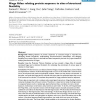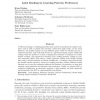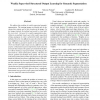362 search results - page 14 / 73 » Identifying Predictive Structures in Relational Data Using M... |
BMCBI
2007
14 years 10 months ago
2007
Background: Relating features of protein sequences to structural hinges is important for identifying domain boundaries, understanding structure-function relationships, and designi...
ISLPED
2004
ACM
15 years 4 months ago
2004
ACM
Designers have invested much effort in developing accurate branch predictors with short learning periods. Such techniques rely on exploiting complex and relatively large structure...
AI
2008
Springer
14 years 11 months ago
2008
Springer
Preference learning is a challenging problem that involves the prediction of complex structures, such as weak or partial order relations, rather than single values. In the recent ...
146
click to vote
CVPR
2012
IEEE
13 years 1 months ago
2012
IEEE
We address the problem of weakly supervised semantic segmentation. The training images are labeled only by the classes they contain, not by their location in the image. On test im...
ICRA
2010
IEEE
14 years 9 months ago
2010
IEEE
Abstract— Autonomous robot navigation in unstructured outdoor environments is a challenging and largely unsolved area of active research. The navigation task requires identifying...



